


Dualtone Automotive 4745 Mission Bay Dr. San Diego, CA 92109 © Dualtone Automotive Inc. 2015
Serving San Diego Since 1946
Toe is the difference in distance between the front and rear of the tires. Toe is
the most important of the alignment angles. As viewed from the top of the vehicle
(a bird’s eye view), zero toe means that both wheels on the same axle are parallel
Toe is also described as a comparison of horizontal lines drawn through both
wheels on the same axle. If the front of the tires is closer than the rear of the same
tires, then the toe is called toe-in or positive toe.
If the front of the tires is farther apart than the rear of the same tires, then the
wheels are toed-out, or have negative toe. The purpose of the correct toe setting is
to provide maximum stability with a minimum of tire wear when the vehicle is being driven.
All vehicles can be adjusted for front toe. Toe is measured in fractions of degrees or in fractions of an inch (usually
1/16s), millimeters (mm), or decimals of an inch (such as 0.06 in.). Incorrect toe is the major cause of excessive tire wear!
If not correct, toe causes camber-type wear on one side of the tire. Feathered wear is also common, especially if the
vehicle is equipped with non-radial tires.
Incorrect front toe does not cause a pull condition. Incorrect toe on the front wheels is split equally as the vehicle is
driven because the forces acting on the tires are exerted through the tie rod and steering linkage to both wheels.
Incorrect (or unequal) rear toe can cause tire wear.
If the toe of the rear wheels is not equal, the steering wheel will not be straight and will pull toward the side with the most
toe-in.
Front toe adjustment must be made correctly by adjusting the tie rod sleeves
Many vehicle manufacturers specify a slight amount of toe-in to compensate for the natural tendency of the front wheels
to spread apart (become toed-out) due to centrifugal force of the rolling wheels acting on the steering linkage.
Normal wear to the tie rod ends and other steering linkage parts usually causes toe-out. Excessive front toe-out will
cause wandering (lack of directional stability), especially during braking. Incorrectly set toe will cause an uncentered steering
wheel. If toe is unequal in the rear, the vehicle will pull toward the side with the most toe-in.

TOE






ALIGNMENT ANGLES
CAMBER
Camber is the inward or outward tilt of the wheels from true vertical as viewed from the front or rear of the vehicle. As
the vehicle is loaded or when the springs sag, camber usually decreases. If camber is kept positive, then the running
camber is kept near zero degrees for best tire life. Camber is not adjustable on many vehicles.
•
If the top of the tire is tilted out, then camber is positive
•
If the top of the tire is tilted in, then camber is negative
•
Camber is zero (0 degrees) if the tilt of the wheel is true vertical
•
Camber can cause tire wear if not correct.
•
Camber can cause pull if it is unequal side-to-side.
•
Incorrect camber can cause excessive wear on wheel bearings.
•
Camber should be equal on both sides when possible
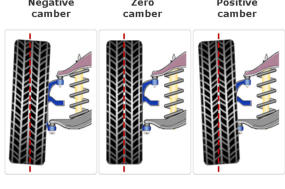

The steering axis is defined as the line drawn through the upper and lower
steering pivot points. On an SLA suspension system, the upper pivot is the upper
ball joint and the lower pivot is the lower ball joint. On a MacPherson strut system,
the upper pivot is the center of the upper bearing mount and the lower pivot point
is the lower ball joint. Zero caster means that the steering axis is straight up and
down, also called 0 degrees or perfectly vertical
Positive caster is present when the upper suspension pivot point is behind
the lower pivot point (ball joint) as viewed from the side.
Negative caster is present when the upper suspension pivot point is ahead
of the lower pivot point (ball joint) as viewed from the side.
Caster is not a tire-wearing angle, but positive caster can cause changes in camber during a turn. This condition is
called camber roll
Caster is a stability angle. If caster is positive, the vehicle steering will be very stable (will tend to go straight with little
steering wheel correction needed). This degree of caster helps with steering wheel return-ability after a turn. If the caster is
positive, steering effort will increase with increasing positive caster. Greater road shocks will be felt by the driver when driving
over rough road surfaces.
Vehicles with as many as 11 degrees positive caster, such as many Mercedes vehicles, usually use a steering dampener
to control possible shimmy at high speeds and to dampen the snap-back of the spindle after a turn. If caster is negative, or
excessively unequal, the vehicle will not be as stable and will tend to wander (constant steering wheel
movement will be
required to maintain straight-ahead direction). If a vehicle is heavily loaded in the rear, caster increases.
Caster can cause pull if unequal; the vehicle will pull toward the side with the least positive caster. However, the pulling
force of unequal caster is only about one-fourth the pulling force of camber. It would require a difference of caster of one full
degree to equal the pulling force of only 1/4-degree difference of camber.
Caster is not adjustable on many vehicles. If caster is adjustable, it is changed by moving either the lower or the upper
pivot point forward or backward using shims, eccentric cams or strut rods. Caster should be nearly equal on both sides;
however, make certain that there is more caster on the right side to help compensate for the crown of the road.
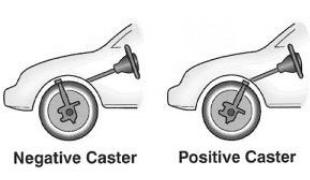
CASTER
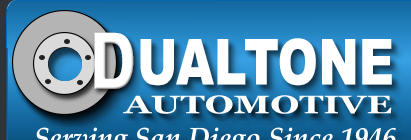
A proper wheel alignment will improve tire life, vehicle performance and fuel efficiency.
Phone: (858) 273-874 (619) 276-4525

8:00am-500pm
8:00am-200pm
Closed




Dualtone Automotive 4745 Mission Bay Dr. San Diego, CA 92109 © Dualtone Automotive Inc. 2015
Serving San Diego Since 1946
Toe is the difference in distance between the front and rear
of the tires. Toe is the most important of the alignment angles. As
viewed from the top of the vehicle (a bird’s eye view), zero toe
means that both wheels on the same axle are parallel
Toe is also described as a comparison of horizontal lines
drawn through both wheels on the same axle. If the front of the
tires is closer than the rear of the same tires, then the toe is
called toe-in or positive toe.
If the front of the tires is farther apart than the rear of the
same tires, then the wheels are toed-out, or have negative toe.
The purpose of the correct toe setting is to provide maximum
stability with a minimum of tire wear when the vehicle is being
driven.
All vehicles can be adjusted for front toe. Toe is measured
in fractions of degrees or in fractions of an inch (usually 1/16s),
millimeters (mm), or decimals of an inch (such as 0.06 in.).
Incorrect toe is the major cause of excessive tire wear!
If not correct, toe causes camber-type wear on one side
of the tire. Feathered wear is also common, especially if the
vehicle is equipped with non-radial tires.
Incorrect front toe does not cause a pull condition. Incorrect
toe on the front wheels is split equally as the vehicle is driven
because the forces acting on the tires are exerted through the tie
rod and steering linkage to both wheels.
Incorrect (or unequal) rear toe can cause tire wear.
If the toe of the rear wheels is not equal, the steering wheel
will not be straight and will pull toward the side with the most toe-
in.
Front toe adjustment must be made correctly by adjusting
the tie rod sleeves
Many vehicle manufacturers specify a slight amount of toe-
in to compensate for the natural tendency of the front wheels to
spread apart (become toed-out) due to centrifugal force of the
rolling wheels acting on the steering linkage.
Normal wear to the tie rod ends and other steering linkage
parts usually causes toe-out. Excessive front toe-out will cause
wandering (lack of directional stability), especially during braking.
Incorrectly set toe will cause an uncentered steering wheel. If toe
is unequal in the rear, the vehicle will pull toward the side with
the most toe-in.
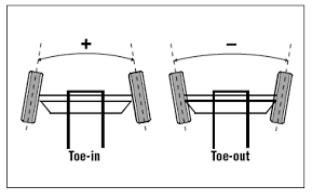
TOE

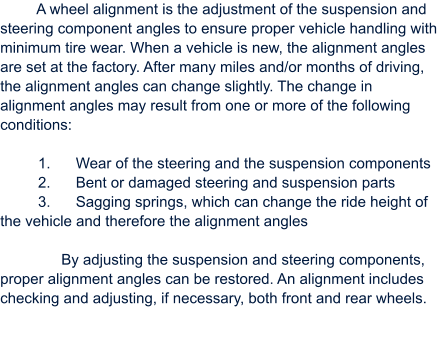
ALIGNMENT ANGLES
CAMBER
Camber is the inward or outward tilt of the wheels from true
vertical as viewed from the front or rear of the vehicle. As the
vehicle is loaded or when the springs sag, camber usually
decreases. If camber is kept positive, then the running camber is
kept near zero degrees for best tire life. Camber is not adjustable
on many vehicles.
•
If the top of the tire is tilted out, then camber is positive
•
If the top of the tire is tilted in, then camber is negative
•
Camber is zero (0 degrees) if the tilt of the wheel is true
vertical
•
Camber can cause tire wear if not correct.
•
Camber can cause pull if it is unequal side-to-side.
•
Incorrect camber can cause excessive wear on wheel
bearings.
•
Camber should be equal on both sides when possible
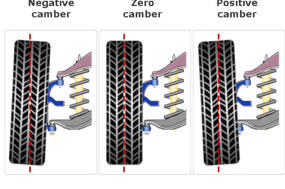
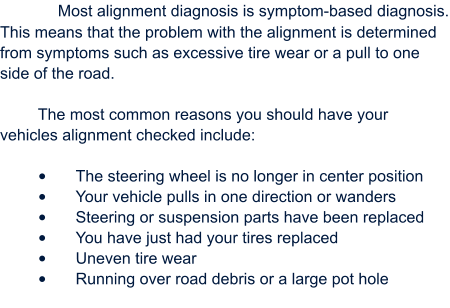
The steering axis is defined as the line drawn through the
upper and lower steering pivot points. On an SLA suspension
system, the upper pivot is the upper ball joint and the lower
pivot is the lower ball joint. On a MacPherson strut system, the
upper pivot is the center of the upper bearing mount and the
lower pivot point is the lower ball joint. Zero caster means that
the steering axis is straight up and down, also called 0 degrees
or perfectly vertical
Positive caster is present when the upper suspension pivot
point is behind the lower pivot point (ball joint) as viewed from
the side.
Negative caster is present when the upper suspension
pivot point is ahead of the lower pivot point (ball joint) as viewed
from the side.
Caster is not a tire-wearing angle, but positive caster can
cause changes in camber during a turn. This condition is called
camber roll
Caster is a stability angle. If caster is positive, the vehicle
steering will be very stable (will tend to go straight with little
steering wheel correction needed). This degree of caster helps
with steering wheel return-ability after a turn. If the caster is
positive, steering effort will increase with increasing positive
caster. Greater road shocks will be felt by the driver when
driving over rough road surfaces.
Vehicles with as many as 11 degrees positive caster, such
as many Mercedes vehicles, usually use a steering dampener
to control possible shimmy at high speeds and to dampen the
snap-back of the spindle after a turn. If caster is negative, or
excessively unequal, the vehicle will not be as stable and will
tend to wander (constant steering wheel
movement will be
required to maintain straight-ahead direction). If a vehicle is
heavily loaded in the rear, caster increases.
Caster can cause pull if unequal; the vehicle will pull
toward the side with the least positive caster. However, the
pulling force of unequal caster is only about one-fourth the
pulling force of camber. It would require a difference of caster of
one full degree to equal the pulling force of only 1/4-degree
difference of camber.
Caster is not adjustable on many vehicles. If caster is
adjustable, it is changed by moving either the lower or the upper
pivot point forward or backward using shims, eccentric cams or
strut rods. Caster should be nearly equal on both sides;
however, make certain that there is more caster on the right
side to help compensate for the crown of the road.
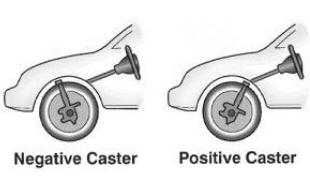
CASTER
A proper wheel alignment will improve tire life,
vehicle performance and fuel efficiency.
DEFINITION OF A WHEEL
ALIGNMENT






